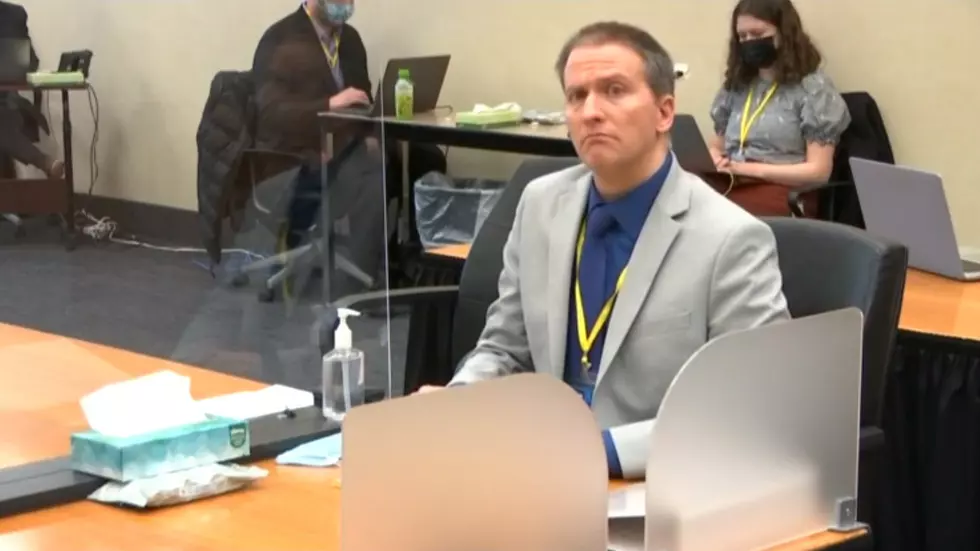
Lung Expert Blames Death of George Floyd on Low Oxygen Levels

MINNEAPOLIS (AP) — George Floyd died of a lack of oxygen from being pinned to the pavement with a knee on his neck, a medical expert testified at former Officer Derek Chauvin’s murder trial Thursday, emphatically rejecting the defense theory that Floyd’s drug use and underlying health problems were what killed him.
“A healthy person subjected to what Mr. Floyd was subjected to would have died as a result of what he was subjected to,” said prosecution witness Dr. Martin Tobin, a lung and critical care specialist at the Edward Hines Jr. VA Hospital and Loyola University’s medical school in Chicago.
Using easy-to-understand language to explain a host of medical concepts, Tobin told the jury that Floyd’s breathing was too shallow to take in enough oxygen while Chauvin and other officers pinned down the 46-year-old Black man on his stomach last May with his hands cuffed behind him and his face jammed against the pavement.
The lack of oxygen resulted in brain damage and caused his heart to stop, the witness said.
Tobin, analyzing a graphic presentation of the three officers holding down Floyd for what prosecutors say was almost 9 1/2 minutes, testified that Chauvin’s knee was “virtually on the neck” for more than 90% of the time by his estimate.
The witness cited several factors that he said had made it difficult for Floyd to breathe, beyond Chauvin’s knee on his neck: officers lifting up on the suspect’s handcuffs, the hard street, his prone position, his turned head, and a knee on his back.
Chauvin kept his knee on Floyd’s neck for 3 minutes, 2 seconds, after Floyd had “reached the point where there was not one ounce of oxygen left in the body,” Tobin said. And he said that after officers found no pulse, the knee stayed on Floyd’s neck for an additional 2 minutes, 44 seconds.
Chauvin, 45, is charged with murder and manslaughter in Floyd’s death May 25. Floyd was arrested outside a neighborhood market after being accused of trying to pass a counterfeit $20 bill.
Bystander video of Floyd crying that he couldn’t breathe as onlookers yelled at Chauvin to get off him sparked protests and scattered violence around the U.S.
Defense attorney Eric Nelson has argued that the now-fired white officer did what he was trained to do and that Floyd’s use of illegal drugs – an autopsy found fentanyl and methamphetamine in his body — and underlying medical problems that included high blood pressure and heart disease caused his death, not Chauvin’s actions.
But Tobin said he analyzed Floyd’s respiration as seen on body-camera video and explained that while fentanyl typically cuts the rate of respiration by 40 percent, Floyd’s breathing was “right around normal.”
Tobin also explained that just because Floyd was talking and shown moving on video, it doesn’t mean he was breathing adequately. He said a person can continue to speak until the airway narrows to 15% — but once it gets below that, it’s dangerous. “At the point where you can’t speak … you are in deep trouble,” he said.
Officers are heard on video telling Floyd that if he can talk, he can breathe.
He said it appeared that Floyd was getting enough oxygen for about the first five minutes to keep his brain alive because he was still speaking.
But Tobin said that where Chauvin had his knee after the five-minute mark would not make much of a difference, because at that point Floyd had already experienced brain damage.
Nelson, Chauvin’s attorney, has repeatedly shown the jury still images from the video that he said showed Chauvin’s knee was on Floyd’s shoulder blade. But nearly all of those images were captured more than five minutes into the ordeal, according to video time stamps.
Tobin explained to jurors what happens as the space in the airway narrows, saying breathing then becomes “enormously more difficult,” like “breathing through a drinking straw.”
He said that if the hypopharynx – the bottom part of the throat — becomes totally obstructed, it takes just seconds to reduce the level of oxygen to where it would result “in either a seizure or a heart attack.”
Prosecutors showed images of Floyd side by side, one with the front of his face pressed against the pavement and another with his head turned. Tobin said that when Floyd’s head was facedown, a ligament at the back of his neck would have protected his airway. But with his head turned, Chauvin’s weight would have compressed the hypopharynx.
The expert calculated that at times when Chauvin was in a near-vertical position, with his toes off the ground, half of Chauvin’s body weight — 91.5 pounds — was directly on Floyd’s neck.
Tobin also reviewed body camera video that showed Floyd’s leg moving upward during the restraint, saying it was involuntary and at that point: “You’re seeing here fatal injury to the brain from a lack of oxygen.”
Tobin used simple language, with terms like “pump handle” and “bucket handle” to describe the act of breathing for jurors. At one point, he invited them to “examine your own necks, all of you in the jury right now” to better understand the effect of a knee on a person’s neck.
Most of the jurors felt their necks as Tobin instructed, though the judge later told them they didn’t have to do so.
CHECK IT OUT: See the 100 most popular brands in America
More From KROC-AM









